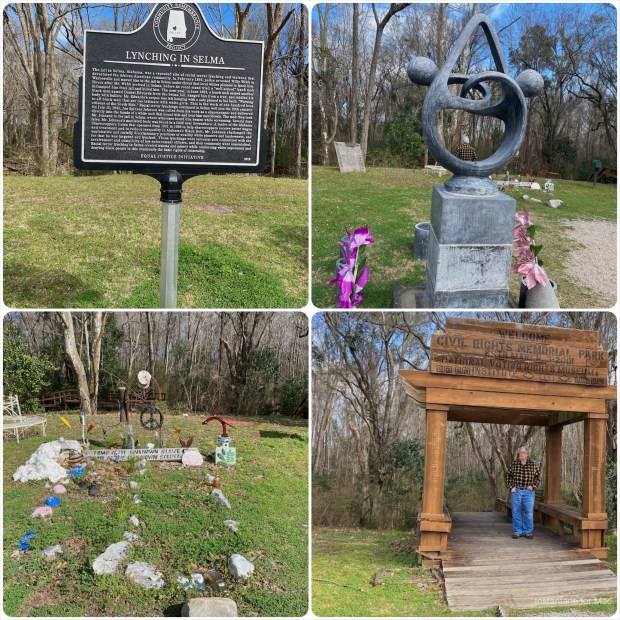Montgomery and Selma
We could easily have spent a week in Montgomery, Alabama and the area around it, but we decided to focus on the Legacy Museum and the Memorial for Peace and Justice (aka “The Lynching Museum.”) Like others who have visited, we had trouble finding the words to describe the museum. The designers take you from the Middle Passage (and you feel like you’re underwater as you read about it) through the error of racial terrorism following Reconstruction. You continue to the present New Jim Crow in our prison system, where you can sit in a chair behind a glass panel and talk to real people about what brought them to prison, and what burdens they are bearing.
In the museum, we found the jar of soil that Rabbi Tom Guttherz and his community brought from the spot where John Henry James was lynched (see Part II) on a giant wall of jars, but we weren’t allowed to take pictures of that or anything else in the museum. And the gift shop didn’t have postcards that captured some of the amazing exhibits, so that was a bummer.
We were allowed, however, to take pictures in the memorial, which records all the lynchings that took place in southern counties.





That evening, we had dinner with the family of Jalil’s daughter, which provided a much-needed shift in mood and a good space to talk about our visit to the museum and news events. Antoinette, or “Toni,” is a fabulous cook, and we were way too full of food and fellowship by the time we left. We were a little distressed to learn that Antoinette and her daughter Amina were making $2.50 an hour working as servers.

The next day in Selma was quite different. The museums and historical markers were less sophisticated but more accessible. The Legacy Museum almost felt as though it came down from On High. You definitely saw the work of dedicated human volunteers keeping the witness of Bloody Sunday and the marches across the Edmund Pettus Bridge in Selma alive.




After the park, we made our way across the bridge and explored the city of Selma.








We walked back over the bridge again and found a small, unassuming museum open across the street from the gift shop. Unlike the high-tech museums we had visited, we could take as many pictures as we wanted in this one.


















Returning from Selma to Montgomery, we stopped at the Rosa Parks museum an hour before it closed. We could only take pictures of the sign out front and her statue in the foyer.

We finished our long day amongst the cloud of witnesses at Connie Bs, which had some darn good soul food. I just ordered sides.






You must be logged in to post a comment.